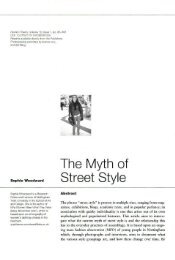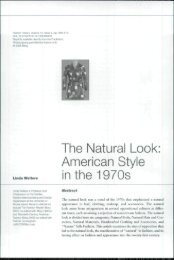Spinning the Ephemeral PDF - SMU Fashion Media
Spinning the Ephemeral PDF - SMU Fashion Media
Spinning the Ephemeral PDF - SMU Fashion Media
Create successful ePaper yourself
Turn your PDF publications into a flip-book with our unique Google optimized e-Paper software.
300 Fiona Anderson<br />
fashion on quotation from <strong>the</strong> past means that it interrupts <strong>the</strong> historical<br />
continuum as Lehmann states:<br />
Through <strong>the</strong> quotation, fashion fuses <strong>the</strong> <strong>the</strong>sis (<strong>the</strong> eternal or<br />
classical ideal) with its anti<strong>the</strong>sis (<strong>the</strong> openly contemporary). The<br />
apparent opposition between <strong>the</strong> eternal and <strong>the</strong> ephemera! is<br />
rendered obsolete by <strong>the</strong> leap that needs <strong>the</strong> past to continue with<br />
<strong>the</strong> contemporary. Correspondingly, <strong>the</strong> transhistorical describes<br />
<strong>the</strong> position of fashion as detached from both <strong>the</strong> eternal, that is,<br />
<strong>the</strong> aes<strong>the</strong>tic, ideal and <strong>the</strong> continuous progression of history.<br />
Through <strong>the</strong> Tigersprung fashion is able to jump from <strong>the</strong> contemporary<br />
to <strong>the</strong> ancient and back without resting solely in one<br />
temporal or aes<strong>the</strong>tic configuration (Lehmann 2000: xviii).<br />
This breaking of <strong>the</strong> historical continuutn through quotation of <strong>the</strong> past<br />
is very similar to actual developments and imagined perceptions of <strong>the</strong><br />
Scottish landscape in <strong>the</strong> late nineteenth century in that <strong>the</strong> creation of<br />
<strong>the</strong> contexts for inherently modern, fashionable lifestyles, necessitated<br />
interrupting <strong>the</strong> "logical" continuum of human progress by turning<br />
millions of acres of pastoral land both backwards and forwards in time<br />
to form a "wilderness" playground. Although images of mountains,<br />
forests, and moors seem scarcely credible as having similarities witb <strong>the</strong><br />
spaces of modern, urban leisure consumption such as <strong>the</strong> department store<br />
or <strong>the</strong> art museum. The changes made to <strong>the</strong> Scottisb landscape and<br />
tbe shifting popular perceptions of that landscape involved a similar<br />
commodification of people's time, experiences of <strong>the</strong> world, and <strong>the</strong>ir<br />
understanding of <strong>the</strong>ir identities witbin it. Even if one takes account of<br />
<strong>the</strong> inherently fluid and unstable relationsbips between landscape and<br />
masculine identities in <strong>the</strong> era of modernity. Tbe development of tweed<br />
as a fasbion textile tbat was widely worn by ail classes of men in botb<br />
rural and urban contexts in <strong>the</strong> late nineteenth century is inconceivable<br />
witbout <strong>the</strong>se fundamental shifts towards new modern conceptions of<br />
landscape, identity, and fashionable consumption.<br />
In tbe consideration of tbe relationships between tweed cloth, rural and<br />
urban landscapes, and fasbion in tbe era of modernity it is useful to<br />
consider wbe<strong>the</strong>r <strong>the</strong> rural also influenced <strong>the</strong> style of men's dress at that<br />
time. Around tbe mid-nineteentb century sbooting jackets or coats, a sbort<br />
style made predominantly in tweed, but also in otber clotbs such as velvet<br />
developed. At that time tbese garments were worn primarily as utilitarian<br />
sporting dress to be worn in <strong>the</strong> country whilst partaking in sports such<br />
as shooting and fishing. The shooting jacket along witb <strong>the</strong> addition of<br />
matching trousers evolved into tbe lounge suit, a style tbat was to dominate<br />
<strong>the</strong> male wardrobe from tbe 1890s, up until <strong>the</strong> late twentieth century<br />
(Anderson 2000: 416). The basic elements of modern men's dress were<br />
tberefore formulated tbrougb a combination of rural and urban influences<br />
and contexts, despite <strong>the</strong> importance of dress codes linked to class and




